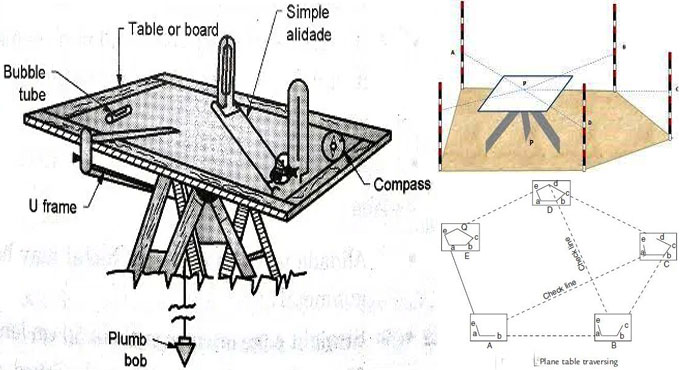
What is Plane Table Surveying
Plane Table Surveying is used in ad-hoc surveying and designing situations. In this, survey fieldwork and plotting work is done simultaneously. Therefore, there is no need for office work. This is best adapted to situations where high precision is not required. Thereby, it is greatly useful for small-scale mapping operations.
Instruments used in Plane Table Surveying - The Plane Table survey method uses very simple instruments. These are available everywhere.
1. Drawing Board: It is a board made of seasoned wood. They are available in many sizes. Generally, the field work is done in 40 cm by 30 cm boards. They also use the 75 cm by 60 cm boards, for larger work. In the field, a tripod is placed under the board with a ball socket in it. This enables the surveyor to draw on the board from any angle.
2. Alidade: An alidade is basically a ruler with a telescope. This is used on the drawing board to draw lines and rays according to the field. The alidade may also have a spirit level on it.
3. Compass: A tough compass is used to find the magnetic meridian of the place. Generally, the compass used in survey work also has two bubble tubes at right angles to each other.
4. Plumbing Fork: It is a rod with a plumbob attached to one end. This is used to ensure that other equipment is aligned perfectly vertically, when needed.
5. Spirit Level: It is a tube of liquid with a bubble inside it. The tube is slightly bulging in the middle. This lets the bubble stay in the middle of the tube when the level is perfectly horizontal. This is used to make sure the drawing board, or other equipment are placed horizontally.
6. Waterproof cover: A waterproof cover is used to cover up the paper on the drawing board from rain or other splashes and dust. This is generally made of soft polythene.
7. Drawing sheet: Excellent quality paper should be used as the drawing sheet. This is because the sheet has to face a lot of rough use in the field. Also, it may get folded and rolled many times. The paper generally used on drawing boards has a tendency to stretch and contract due to altering humidity. For this reason, the paper should be seasoned for a week before usage.
8. Tripod: The tripod is essential in surveying because it helps mount all other instruments, especially the drawing board.
The tripod may be fitted with different sorts of mounts as needed.
1. Advantages of Plane Table Surveying
2. Both field and plotting work done at once
3. Maintaining field notes not required
4. Separate office work for plotting not required
5. Direct measurements not required since they are taken graphically
6. Suitable for magnetic areas where compasses are not reliable
7. Takes less time and less investment
8. Preparing small-scale maps are easiest with this
9. Contours and irregular objects are more easily represented
10. A tangent clinometer can also help find out reduced level of points
11. Not much skill required to complete the survey
Disadvantages of using Plane Table Survey: This method is not good for accurate surveying. Also, you cannot do this in wet climates. Large areas cannot be covered by this survey as well. Not to mention handling a drawing board in the field may be very inconvenient.


